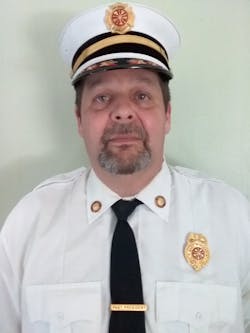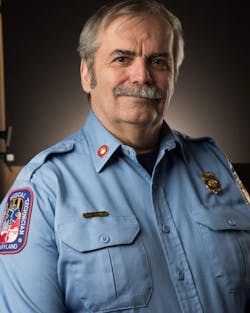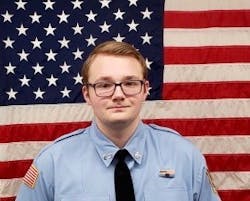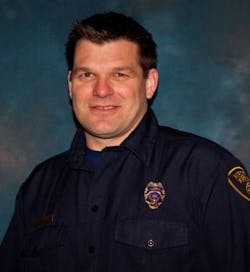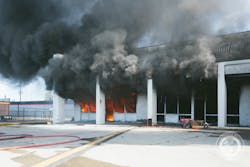Fire Service Achievement Award Winners
The National Volunteer Fire Council (NVFC) announced the 2020 winners of its four national fire service awards.
“This year’s nominees were truly outstanding and demonstrate the meaning of excellence in the volunteer fire and emergency services,” said NVFC Chair Steve Hirsch. “The NVFC commends all of the award winners for the remarkable impact they have made on their departments, communities and the volunteer fire service. Now more than ever, the commitment and service that these recipients showcase serve as an inspiration not only for their fellow volunteers but for the nation and world.”
The recipients of the NVFC’s 2020 awards are as follows:
Sponsored by OnStar
Brooks has been a member of the East Windsor Volunteer Fire Company No. 1 since April 1979, when he joined as a junior firefighter. Throughout his 41 years with the department, Brooks served in various key positions of leadership, including trustee, president, vice president, lieutenant, captain, assistant chief, deputy chief and chief.
Brooks has been instrumental in procuring and designing the township's fire apparatus, including the engine, rescue, tele-squirt, mini pumper and ladder. He consistently is a top 10 responder for the company, answering several hundred calls annually. ln addition to serving as the longest active riding firefighter in East Windsor, he also holds the distinction of being the youngest elected fire chief in Mercer County, NJ.
David Lewis—NVFC James P. Seavey Sr. Health and Wellness Leadership Award
Award co-sponsored by Ward Diesel Filter Systems and VFIS
A 40-year veteran of the fire and emergency medical services, Lewis always has been an advocate for firefighter health, wellness and safety.
At the state level, Lewis has served on several committees within the Maryland State Firemen's Association, culminating in his term as president from 2011–2012. While president, he reorganized the association's Safety Committee, with increased responsibilities to advocate for health and safety practices across the state. He also created the Cancer Support Committee, which partnered with the Firefighter Cancer Support Network to provide a support structure for firefighters and their families who are going through cancer treatments.
At the national level, Lewis serves as one of two Maryland directors to the NVFC. As a member of the NVFC's Health, Safety, and Training Committee, he seeks opportunities to develop and deliver health, wellness and safety programs across the country.
Award sponsored by California Casualty
When Cieciuch turned 16, he became a junior firefighter for the Secaucus, NJ, Fire Department. With the blessings of his superiors, he helped modernize the department by creating a website and several Facebook pages, where he listed all of the training courses that are available to new junior firefighters, so these individuals can obtain some basic firefighting knowledge prior to attending the fire academy. Cieciuch has recruited more than 25 members to the junior firefighter program and has been given permission by the chief of the department to oversee the program.
He attended the Bergen County Fire Academy and received his Junior Firefighter I certification and Firefighter I certification. He also attended advanced training and received his I-200, I-300 and I-400 Incident Management certifications. He recently became a member of the Secaucus Fire Department, following in the footsteps of his father, former Chief Raymond Cieciuch.
Westhampton Beach, NY, Fire Department Junior Program—Junior Firefighter Program of the Year Award
Award sponsored by California Casualty
The Westhampton Beach Fire Department Junior Program allows youth the opportunity to gain technical skills that they can apply in the future as a career or volunteer member of the fire and emergency services. The 2020 program has 28 members, who participated in many community fundraisers and events throughout the year, including a polar plunge, a community beach clean-up, a gala to benefit a cancer hospice and an open house at the fire department, during which they taught fire education. Additional planned activities include attending parades and baking cookies for widowers, senior members of the fire department and the food pantry.
For more information on the award winners, visit nvfc.org/awards.
Browning Selected as Safety Award Recipient
The NFPA’s Fire Sprinkler Initiative and the Home Fire Sprinkler Coalition (HFSC) awarded Chase Browning from the Medford, OR, Fire Department the 2019 Bringing Safety Home Award. The award recognizes fire service members and other safety advocates who use HFSC’s home fire sprinkler educational materials and Fire Sprinkler Initiative (FSI) resources to educate local officials as part of an effort to upgrade or pass new home fire sprinkler legislation.Browning, who is the chair of the Oregon Fire Sprinkler Coalition, participated in HFSC’s Fire Sprinkler Developer Incentives program, working alongside several builders and developers. He participated in the code adoption process with Oregon’s Building Codes Division (BCD), making certain that the BCD doesn’t amend NFPA 13D: Standard for the Installation of Sprinkler Systems in One- and Two-Family Dwellings and Manufactured Homes. While working in the HFSC pilot process for the incentives campaign, Browning continues to educate builders/developers on the financial benefits of the incentives and hopes to see more voluntary use of sprinklers.
“Deputy Fire Marshal Browning is an excellent example of the many local champions working to reduce loss from home fires by acting locally to increase the number of new homes built with sprinklers,” said Lorraine Carli, who is NFPA vice president of outreach and advocacy and HFSC president. “We are extremely pleased to present this award to such an active life safety advocate.”
With Browning’s support, the Oregon Fire Sprinkler Coalition developed 11 educational presentations, which are posted on the Coalition website and are used to promote home fire sprinklers throughout the state. All are based on HFSC, NFPA and FSI materials. Browning also started developing a home fire sprinklers best practices guide, with plans to share it with others across the country.
As the Bringing Safety Home Award recipient, Browning was awarded a $1,000 grant to further fire sprinkler advocacy and educational efforts in his community.
For more, visit homefiresprinkler.org.
Report on Ventilation During Strip Mall Fires
The UL Firefighter Safety Research Institute (FSRI) released a new research report, “Exploratory Analysis of the Impact of Ventilation on Strip Mall Fires,” which is based on the third series of experiments that were conducted as part of the “Study of Coordinated Fire Attack Utilizing Acquired Structures.” This project was funded by the U.S. Department of Homeland Security (DHS) and FEMA’s Assistance to Firefighters Grant Program.
The purpose of the study was to increase fire service knowledge of fire dynamics and the impact of firefighting tactics through a better understanding of how suppression and ventilation are coordinated on the fireground in acquired commercial structures.In conjunction with the fire service project technical panel, UL FSRI engineers developed and conducted a series of full-scale experiments inside of four units of a 12-unit acquired strip mall that was slated for demolition. Beginning with a baseline case of no intentional fire service ventilation, three experiments focused on additional horizontal ventilation, and three focused on the combination of additional horizontal and vertical ventilation. Control variables included the ventilation method, total ventilation area provided and timing relative to water application. These acquired structure experiments were conducted in collaboration with the City of Fairborn, OH, Fire Department.
This report provides a fire dynamics analysis of each experiment, a discussion of ventilation and pressure, and tactical considerations that were developed with the project technical panel.
“Firefighter health and safety is primary to the work that we do,” said Steve Kerber, who is vice president, research, UL FSRI. “We feel that if firefighters are as smart as they can possibly be, they will be safe, they will be effective, there will be less line-of-duty-deaths, fewer injuries, and more lives saved around the world.”
The final report, which focuses on the multifamily residential experiments that were conducted for this study, will follow soon. Additionally, online courses are being developed and will be available through the UL FSRI Fire Safety Academy.
To learn more, visit ULFirefighterSafety.org.
This Month in Fire History
June 5, 1973, Chicago—LaSalle Hotel fire kills 61
June 14, 2017, London—Grenfell Tower fire kills 71
June 15, 1904, New York—SS General Slocum steamship fire kills 1,030
June 17, 1972, Boston—Hotel Vendome fire kills nine firefighters
June 17, 2001, New York—Father’s Day fire kills three firefighters
June 18, 2007, Charleston, SC—Sofa Super Store fire kills nine firefighters
June 24, 1973, New Orleans—UpStairs Lounge fire kills 32
June 26, 1977, Columbia, TN—Maury County Jail fire kills 42
June 30, 2013, Yarnell, AZ—19 Granite Mountain Hotshots died while battling a massive wildland fire
Courtesy: NFPA
About the Author
Firehouse Staff
Content written and created by Firehouse Magazine editors.

